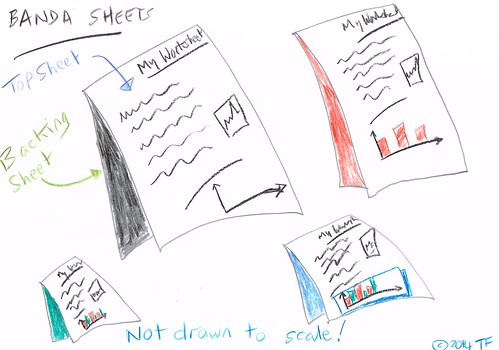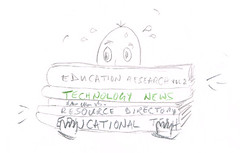My grim and distant techie past: the uni years, part 2
In this occasional series, I am outlining the sort of technology I’ve been obliged to use at various stages of my life. On the whole, I think things are much easier now than they have been at any time in the past, especially for teachers. When I did my first degree, for instance, photocopiers produced poor quality copies, very slowly, and at an exorbitant cost. (I wrote about this in the article My grim and distant techie past: the uni years, part 1.) These days, you can buy a multifunction printer for less than £30 (under $50), and have a photocopier, in effect, right there on your desk at home, producing copies for a few pennies each.
Once I left university clutching my degree certificate, I hastened to enrol for a Post-Graduate Certificate of Education (ie teacher training) course at Brunel University. I didn’t know much about the university, but on being shown around prior to my interview, I realised very quickly that the campus was awash with technology. So when, in the interview, the interviewer asked me what I thought of the idea of teachers using technology, I replied something to the effect that it would be a poor teacher who didn’t try to use different types of technology in order to do the best possible job they could.
“Ah”, replied the interviewer. “You sound like the sort of person we want here.”
And I was offered a place on the course.
The interesting thing for me is that, on a conscious level, I knew that that was the correct answer to give, but I wasn’t entirely certain that I actually agreed with it. After all, teaching, according to ancient wisdom, may be summarised quite succinctly as:
“First I tells ‘em what I’m going to tell ‘em; then I tells ‘em; then I tells ‘em what I’ve told ‘em.”
Surely you don’t need a vast amount of cutting edge technology to do that?
The reason that I said my answer to the interviewer was “interesting” is that I discovered quite quickly that I really did believe what I said! In fact, I still do: take a look at my answers to @ictevangelist’s three questions about technology; especially:
“[…] what sort of education would it be WITHOUT technology?”
Brunel University was just 11 years old when I started my course there. It had been born in 1966, only three years after Harold Wilson waxed lyrical about the white heat of technology. I have to tell you, it was fantastic. It was a long time ago now, but here’s what I remember about the technology we were allowed taught how and encouraged to use. Remember, this was in 1975.
- Video cameras to record ourselves teaching; that may not sound like a big deal today, but back then video cameras were large, expensive, and almost unheard of in schools;
- study booths containing video players and cassette tape players: again, almost unheard of. Schools’ educational film material comprised television programmes that has to be watched as they were being broadcast, and 16mm films, and still slides;
- extensive video and audio cassette library
- overhead projectors: we were taught how to create permanent transparencies with overlays in order to demonstrate processes
- banda duplicators: we were shown how to create multicoloured worksheets; there’s a nice article about this by Rosemary Hampton: The school banda.
- stencil duplicators: we were shown how to create stencil-based worksheets – including multicoloured ones, which I can tell you were extremely laborious to do!
- We were also shown how to create linear and branching “programmed learning” materials for use in the classroom. (If you’re interested in how that worked, you’re in luck: I wrote about it in My analogue program.)
These days, you can achieve all of the above, but so very much more easily. Taking the items listed above in turn:
- Easily achievable now. If your school doesn’t have a video camera, you can just ask a colleague to film you with their phone. Yes, I realise you will need to think about permissions and so on, but my point is the tools needed to make such a record are carried around in people’s pockets and handbags;
- everyone has access to such resources now: there’s the internet of course, not to mention the Teachers’ TV archive, iPlayer and similar, YouTube, etc etc;
- see #2 above;
- you can achieve the same thing now using interactive whiteboard software or PowerPoint, or video animation;
- multicoloured worksheets were fun to create with a banda, but could take hours. The different colours were produced by changing the backing sheet: see illustration.
 Illustration to show the top sheet and backing sheet of a banda, and the process of producing a multicoloured.worksheet
Illustration to show the top sheet and backing sheet of a banda, and the process of producing a multicoloured.worksheet
The backing sheet was a layer of ink, in effect, so that when you wrote on the top sheet, your text or drawings were that colour. So let’s say you wanted to produce a bar chart with different coloured bars to represent male and female. You had to draw the female bars using one backing sheet, then change the backing sheet before drawing the male bars; - as for multicoloured worksheets using a stencil, life was too short. You would have to change the drum inside the machine, and then clean the rollers to get rid of the first lot of ink used. Then you would have to line up the stencil absolutely precisely, otherwise you would end up with the new coloured parts not being aligned properly with the original ones;
- as you can see from the article mentioned above, creating a programmed learning resource was very time-consuming. Actually, it still is, but at least now if you make a mistake you can correct it very easily, leaving no trace of the error; that’s much harder to do when you’re working with paper.
I don’t miss the old technology, but I do think there were two advantages of using it compared with what we have today.
First, it did make you more careful. If, for example, you made a mistake while preparing a stencil-based worksheet, it was a terrible job to correct it. In fact, sometimes it would be quicker for you to just start again. So, you tended to not make mistakes!
Second – and this is almost the opposite point – because it took so much effort to produce something good, you didn’t fall into the trap of trying to make it perfect. Nowadays you can tweak and tweak and tweak until you realise that your worksheet has been through 15 iterations and it’s now gone 2 am. Forty years ago, you very quickly reached the point where you said: “this is good enough”.
Nevertheless, I’d never go back to those old ways even if I could.
One last thing. Having been spoilt by Brunel, it was always my dream to have a sort of reprographics room in my home, a room where I could prepare fantastic materials and not worry about the cost of reproducing them. Well, now I have all that: except it’s not a room, but a computer, printer and connection to the internet!
 Your newsletter editor is hard at work doing research for Digital Education, the free newsletter for education professionals. Have you subscribed yet?
Your newsletter editor is hard at work doing research for Digital Education, the free newsletter for education professionals. Have you subscribed yet?
Read more about it, and subscribe, on the Newsletter page of the ICT in Education website.
We use a double opt-in system, and you won’t get spammed.